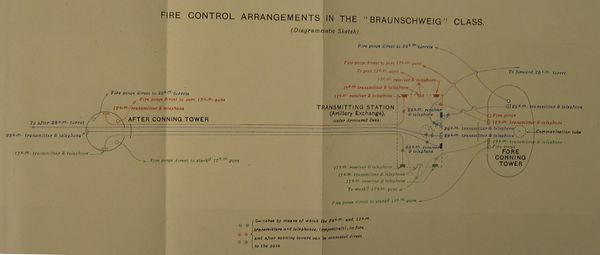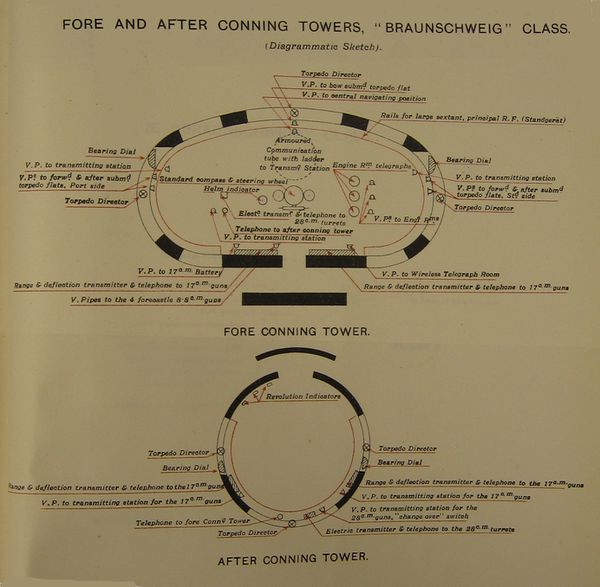Braunschweig Class Battleship (1902)
The five pre-dreadnoughts of the Braunschweig class were completed between 1904 and 1906.
| Overview of 5 vessels | |||||
|---|---|---|---|---|---|
| Citations for this data available on individual ship pages | |||||
| Name | Builder | Laid Down | Launched | Completed | Fate |
| Braunschweig | Germaniawerft | 1901 | 20 Dec, 1902 | 15 Oct, 1904 | Broken up 1931 |
| Elsaß | 1901 | 26 May, 1903 | 29 Nov, 1904 | Discarded 1931 | |
| Hessen | 1902 | 18 Sep, 1903 | 19 Sep, 1905 | Converted 1935 | |
| Lothringen | 1902 | 27 May, 1904 | 18 May, 1906 | Broken up 1931 | |
| Preußen | 1902 | 30 Oct, 1903 | 12 Jul, 1905 | Discarded 1929 | |
Fire Control, c1909
In 1909, the British obtained a great deal of information on the class's particulars, offering us a fairly detailed understanding of her equipment and methods of their use, constrained by whatever limitations in accuracy such intelligence may suffer.[1]
In 1909, there was no rate-of-change instruments or range clocks, but they were introduced later. The organization seems atrocious, inviting the question as to whether the British information was correct.
The First Artillery Officer in the fore conning tower carried a flexible voicepipe to the transmitter operator on the engaged side. The ranges are called out by the range-readers, and are passed to the transmitter operator by the First Artillery Officer. They are passed to the guns by telephone and by transmitter. Spotting corrections are applied directly to the range scale of the rangefinder, the range read at once calling out the new range to be passed to the guns.
The deflection is given by the First Artillery Officer, summing the dumaresq deflection, wind deflection, and so forth; officers of quarters go not give deflection orders except when in local control. The target bearing was read off a bearing indicator and passed to the guns by phone; the bearing of each turret was read through a sighting hole in the floor of each turret.
The 28-cm and 17-cm guns were handled separately, with the First Artillery Officer controlling one, and the Second the other; in the Braunschweig, the First Artillery Officer chose the 17-cm battery for himself.
The First Artillery Officer would pass orders such as
- Bearing (in degrees)
- Description of target
- Range in hundreds of metres
- Deflection in 1⁄16 degree units
Ranging would be carried out by Teilsalven (partial broadside salvoes) of 3-4 17-cm guns. The 28-cm guns joined in once the smaller guns had straddled, and rapid independent fire chosen when the range rate was near zero or the range was short.
The order for "Cease fire" ("Halt!" in German) was relayed by telephone, as there were no cease fire gongs.
There were no special means offered for split fire on the same broadside, but if one 28-cm turret could not bear, it could be placed into local control to engage a suitable second target, the turret officer being responsible for all fire control.
Ranges from rangefinder in the fore lower top were passed by voicepipe to the monkey island and then relayed by a megaphone mouthpiece in the roof of the conning tower.
In the event of the fore conning tower being knocked out, the failure of communications with it would prompt the officers of quarters to assume local control of their groups. They would transmit ranges by electrical instruments to the T.S. which would re-transmit them to the gun positions.
There was an odd arrangement that one gun from each 28-cm turret would be employed along with the entire rest of the armament in repelling torpedo boat attack.
Fore Conning Tower, c1909
Each 17-cm broadside had a range, order and deflection transmitter and a telephone connected to receivers in the T.S. situated in the fore C.T. low down on the wall near the entrance where an operator would be seated. Each position had seven switches to ring single-stroke fire gongs at each gun on the broadside, as well as an eighth which rang all gongs on that broadside together.
A similar, single set of phone, transmitter and fire gong switches was used for the 28-cm guns, the transmitter of which could be used for either or both 28-cm and 17-cm turrets. These devices could all be switched to transmit directly to the guns rather than to the T.S..
There was also a phone to talk to the after conning tower.
Three voicepipes went to the T.S., one to the central navigating position (located near the transmitting station), and another to the W/T room. Four voicepipes went to the four 8.8-cm guns on the forecastle and a single one to the 17-cm battery. Semi-circular bearing indicators with a movable pointer with open sights were located to both sides.
After Conning Tower, c1909
Generally similar in equipment to the fore {CT}}. Three revolution indicators and a course indicator were found alongside the fire control instruments.
Transmitting Station, c1909
The T.S. contained
- receivers for 28-cm transmitters and telephones in the fore and in the aft C.T.s
- transmitters and telephones to the fore and to the aft 28-cm turrets
- receivers for 17-cm transmitters and telephones in the fore and in the aft C.T.s
- transmitters and telephones to the 17-cm guns
The last transmitted simultaneously to all seven guns, but any gun could be cut out if desired. A switch in the T.S. permitted the transmitters in the C.Ts. to transmit directly to the guns.
See Also
Footnotes
- ↑ German Navy: Part IV, Section 4. Target Practice, Range-finders and Control of Fire. pp. 22-3, 26.
Bibliography
| Braunschweig Class Pre-dreadnought | |||||||||||||||||||||||||||||||||||||||||||||||||||||||||||||||||||||||||||||||||||||||||||||||||||||||||||||||||||||||
| Braunschweig | Elsaß | Hessen | Lothringen | Preußen | |||||||||||||||||||||||||||||||||||||||||||||||||||||||||||||||||||||||||||||||||||||||||||||||||||||||||||||||||||
| <– | Wittelsbach Class | Battleships (DE) | Deutschland Class | –> | |||||||||||||||||||||||||||||||||||||||||||||||||||||||||||||||||||||||||||||||||||||||||||||||||||||||||||||||||||

